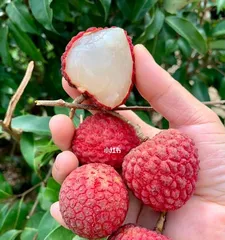Lychee is one of the most popular tropical fruits, not only for its delicious taste but also for its rich nutritional value. How to cultivate lychee trees that grow well and produce sweet, abundant fruit has become a focus for many fruit farmers and lychee enthusiasts. This article will introduce you to the methods of lychee planting and care.

I. Site Selection and Soil Conditions: To grow lychees well, it's essential to choose a suitable planting site. Lychees thrive in a warm and humid environment, with an optimal growing temperature of 22-30°C. The soil pH should be between 5.0 and 6.5, and the soil should be loose, fertile, rich in organic matter, and maintain appropriate moisture levels.
II. Seedling Selection and Planting Time: Purchasing healthy seedlings is a crucial prerequisite for successful planting. When selecting seedlings, choose those that are complete in appearance, with sturdy branches, well-developed roots, and free from pests and diseases. Plant lychees in spring or autumn when the temperature is suitable. The seedlings should be planted in soil pits 30-40 cm deep and 60 cm in diameter, with the spacing between trees and rows controlled according to the size of the canopy.

III. Timely Pruning: Pruning lychees is an important measure to promote growth and improve fruit quality. The main purpose of spring pruning is to promote the germination of new buds and the growth of branches, while autumn pruning is to prepare the tree for dormancy and the next year's growth. When pruning, it's important to use appropriate tools, clean the wounds, and dispose of the pruning waste properly.
IV. Fertilization and Watering: Lychee growth requires an adequate supply of water and nutrients. Fertilization should be based on soil properties and growth stage, and necessary elements such as nitrogen, phosphorus, and potassium should be supplemented in a timely manner. Pay attention to controlling the amount and frequency of watering to avoid waterlogging and drought.
V. Pest and Disease Control: Common pests and diseases for lychee trees include lychee scale, lychee leaf mite, and black spot disease. Regular inspections are necessary to detect problems promptly and take corresponding control measures, such as spraying pesticides or using biological control agents.

VI. Maintaining a Suitable Tree Shape: Lychee trees can have various shapes such as single-trunk, multi-branched, and dragon-pillar types. Depending on the planting purpose, geographical environment, and the tree's own characteristics, a suitable shape should be selected for pruning and cultivation to ensure both yield and healthy tree growth.
VII. Strengthening Tree Support: Lychee trees are prone to tilting and breaking due to the weight of fruit during the initial growth and fruiting periods. Support for the tree should be strengthened at the time of planting, and the support structures should be regularly inspected and reinforced to ensure the healthy growth of the tree.
VIII. Harvesting and Storage: The lychee harvest season is generally from July to August. It's important to choose the right time for harvesting to avoid loss and waste. After harvesting, lychees should be promptly cleaned, packaged, and stored to maintain their quality and taste.
The planting and care of lychees require comprehensive control over aspects such as site selection, seedling selection, pruning, fertilization, watering, pest and disease control, tree shape cultivation, support reinforcement, and harvesting and storage. This will enable the lychee trees to grow abundantly and produce sweet fruit. It is hoped that this article can provide some reference and help to readers who are currently growing lychees.